engine oil YAMAHA XL 700 2001 User Guide
[x] Cancel search | Manufacturer: YAMAHA, Model Year: 2001, Model line: XL 700, Model: YAMAHA XL 700 2001Pages: 111, PDF Size: 12.05 MB
Page 47 of 111
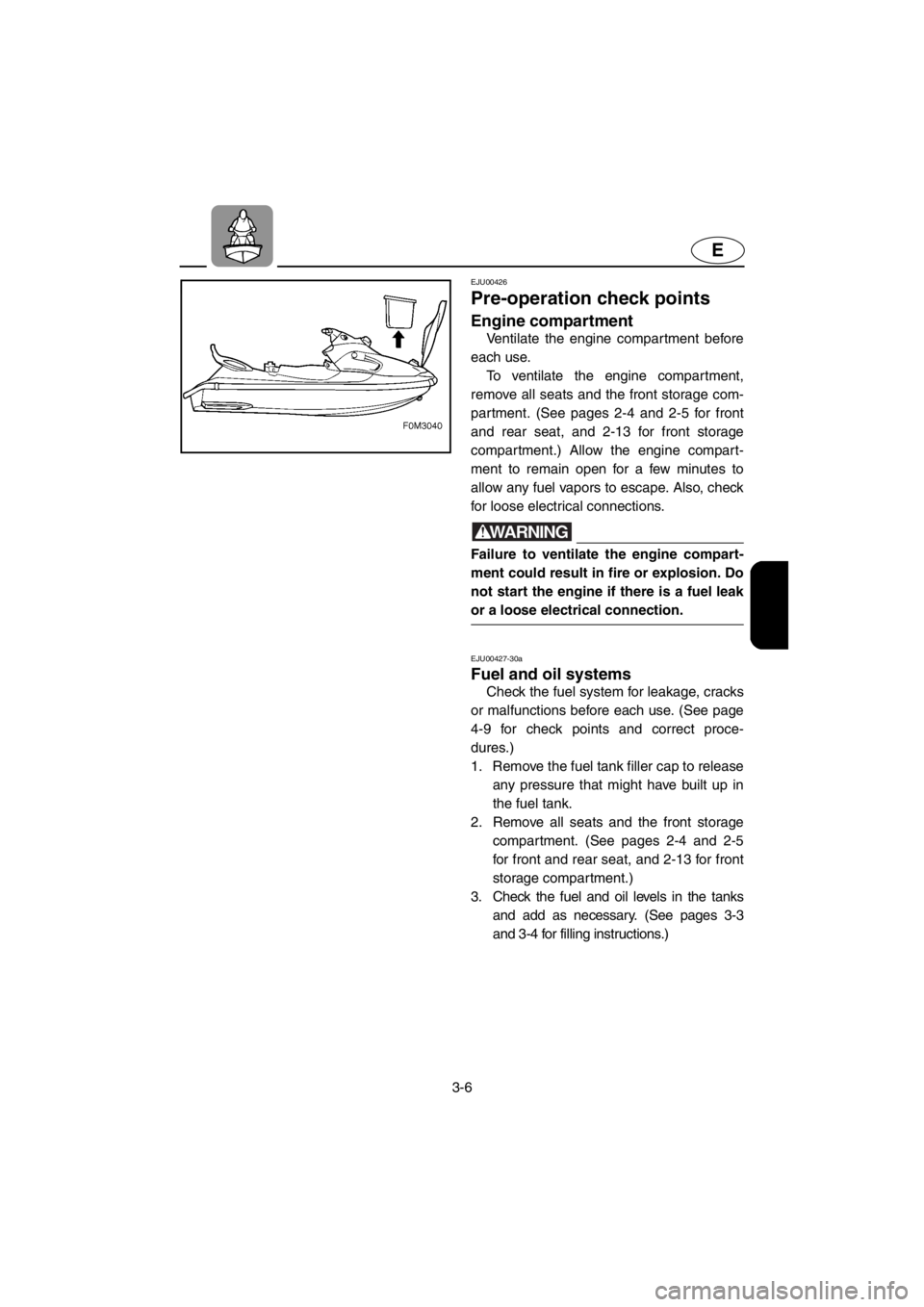
3-6
E
EJU00426
Pre-operation check points
Engine compartment
Ventilate the engine compar tment before
each use.
To ventilate the engine compartment,
remove all seats and the front storage com-
partment. (See pages 2-4 and 2-5 for front
and rear seat, and 2-13 for front storage
compartment.) Allow the engine compart-
ment to remain open for a few minutes to
allow any fuel vapors to escape. Also, check
for loose electrical connections.
WARNING
Failure to ventilate the engine compart-
ment could result in fire or explosion. Do
not start the engine if there is a fuel leak
or a loose electrical connection.
EJU00427-30a
Fuel and oil systems
Check the fuel system for leakage, cracks
or malfunctions before each use. (See page
4-9 for check points and correct proce-
dures.)
1. Remove the fuel tank filler cap to release
any pressure that might have built up in
the fuel tank.
2. Remove all seats and the front storage
compartment. (See pages 2-4 and 2-5
for front and rear seat, and 2-13 for front
storage compartment.)
3. Check the fuel and oil levels in the tanks
and add as necessary. (See pages 3-3
and 3-4 for filling instructions.)
E_F0M-72-3.fm Page 6 Thursday, July 27, 2000 9:52 AM
Page 54 of 111
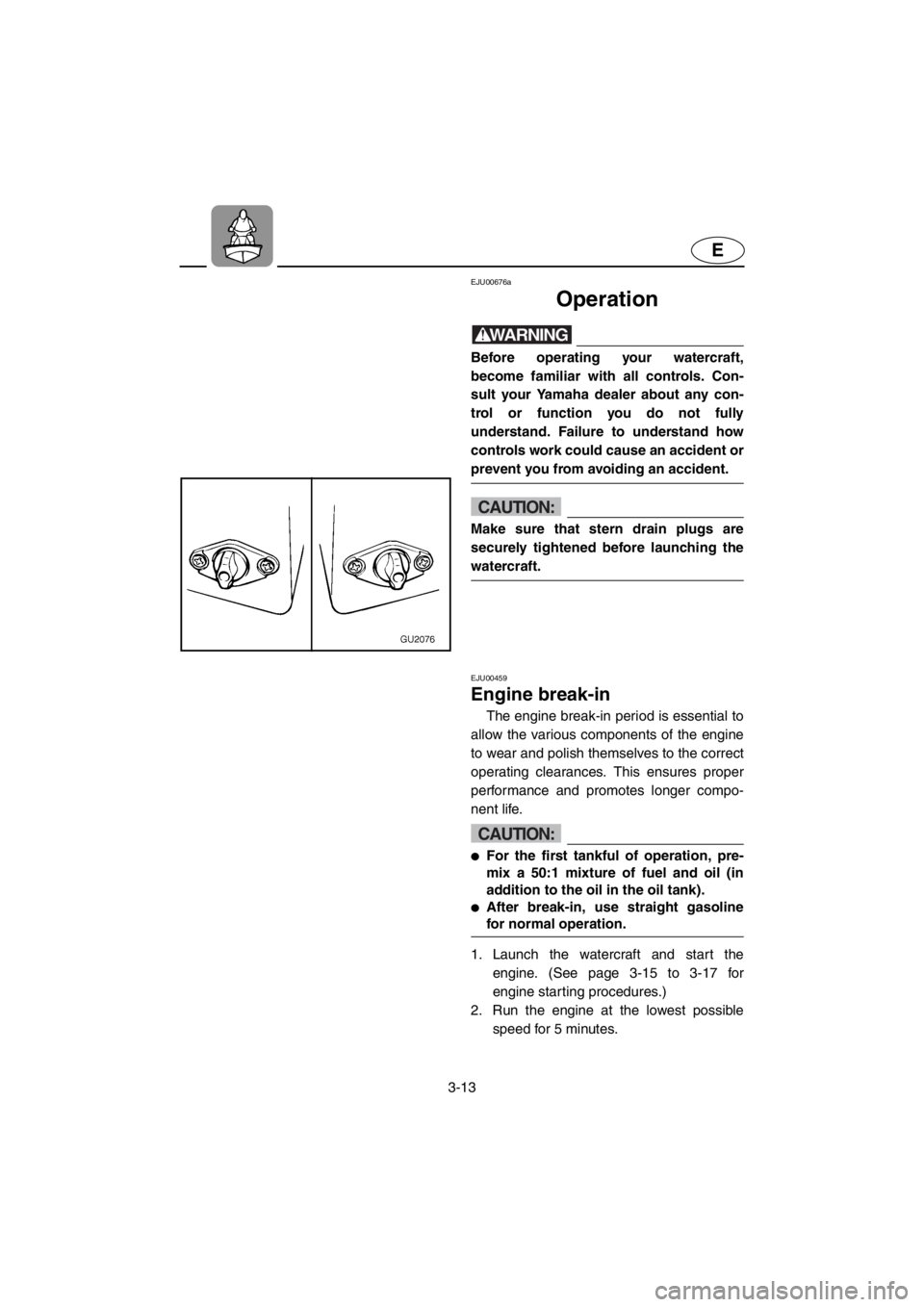
3-13
E
EJU00676a
Operation
WARNING
Before operating your watercraft,
become familiar with all controls. Con-
sult your Yamaha dealer about any con-
trol or function you do not fully
understand. Failure to understand how
controls work could cause an accident or
prevent you from avoiding an accident.
CAUTION:
Make sure that stern drain plugs are
securely tightened before launching the
watercraft.
EJU00459
Engine break-in
The engine break-in period is essential to
allow the various components of the engine
to wear and polish themselves to the correct
operating clearances. This ensures proper
performance and promotes longer compo-
nent life.
CAUTION:
●For the first tankful of operation, pre-
mix a 50:1 mixture of fuel and oil (in
addition to the oil in the oil tank).
●After break-in, use straight gasoline
for normal operation.
1. Launch the watercraft and start the
engine. (See page 3-15 to 3-17 for
engine starting procedures.)
2. Run the engine at the lowest possible
speed for 5 minutes.
E_F0M-72-3.fm Page 13 Thursday, July 27, 2000 9:52 AM
Page 67 of 111
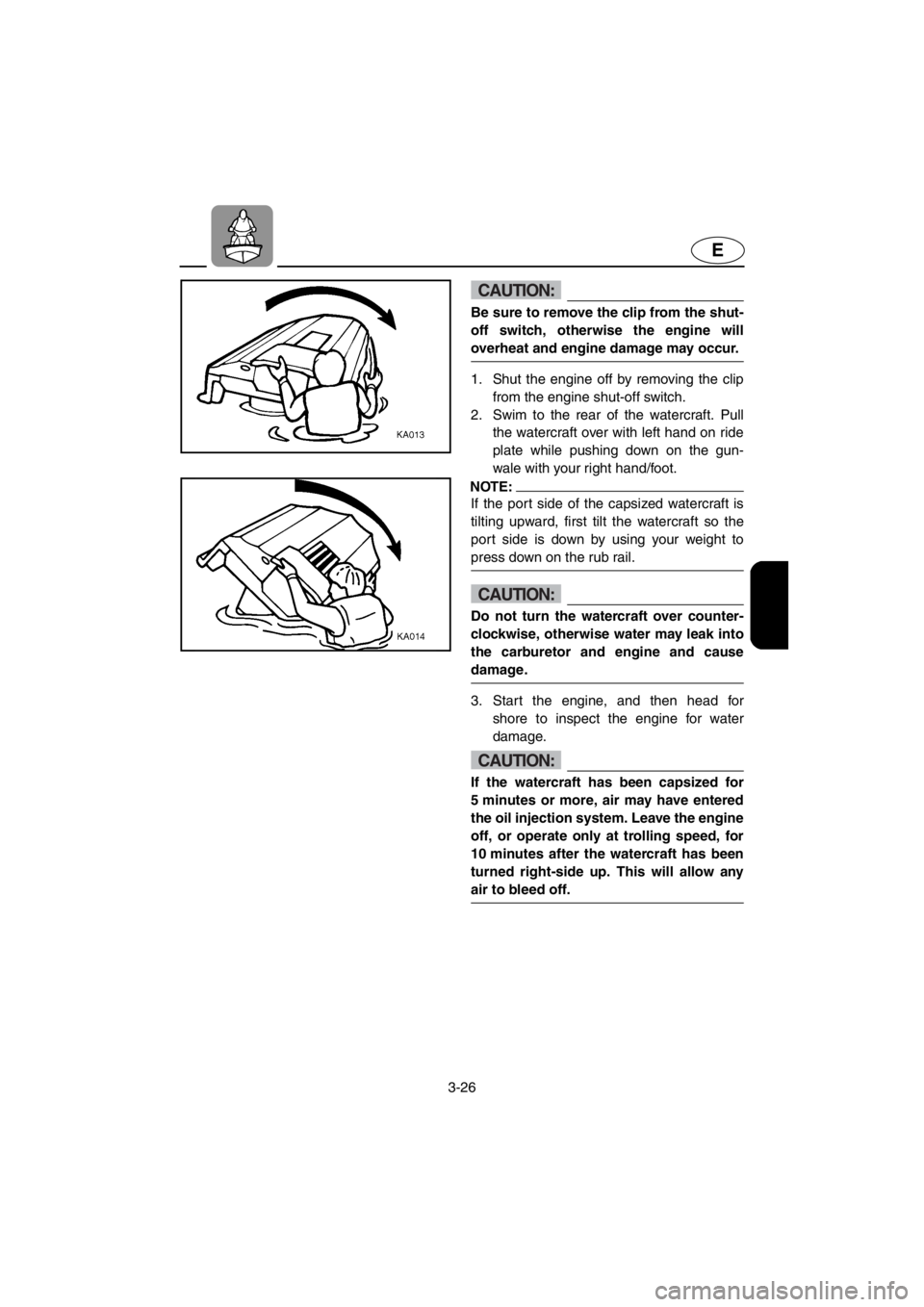
3-26
E
CAUTION:
Be sure to remove the clip from the shut-
off switch, otherwise the engine will
overheat and engine damage may occur.
1. Shut the engine off by removing the clip
from the engine shut-off switch.
2. Swim to the rear of the watercraft. Pull
the watercraft over with left hand on ride
plate while pushing down on the gun-
wale with your right hand/foot.
NOTE:
If the port side of the capsized watercraft is
tilting upward, first tilt the watercraft so the
port side is down by using your weight to
press down on the rub rail.
CAUTION:
Do not turn the watercraft over counter-
clockwise, otherwise water may leak into
the carburetor and engine and cause
damage.
3. Start the engine, and then head for
shore to inspect the engine for water
damage.
CAUTION:
If the watercraft has been capsized for
5 minutes or more, air may have entered
the oil injection system. Leave the engine
off, or operate only at trolling speed, for
10 minutes after the watercraft has been
turned right-side up. This will allow any
air to bleed off.
E_F0M-72-3.fm Page 26 Thursday, July 27, 2000 9:52 AM
Page 78 of 111
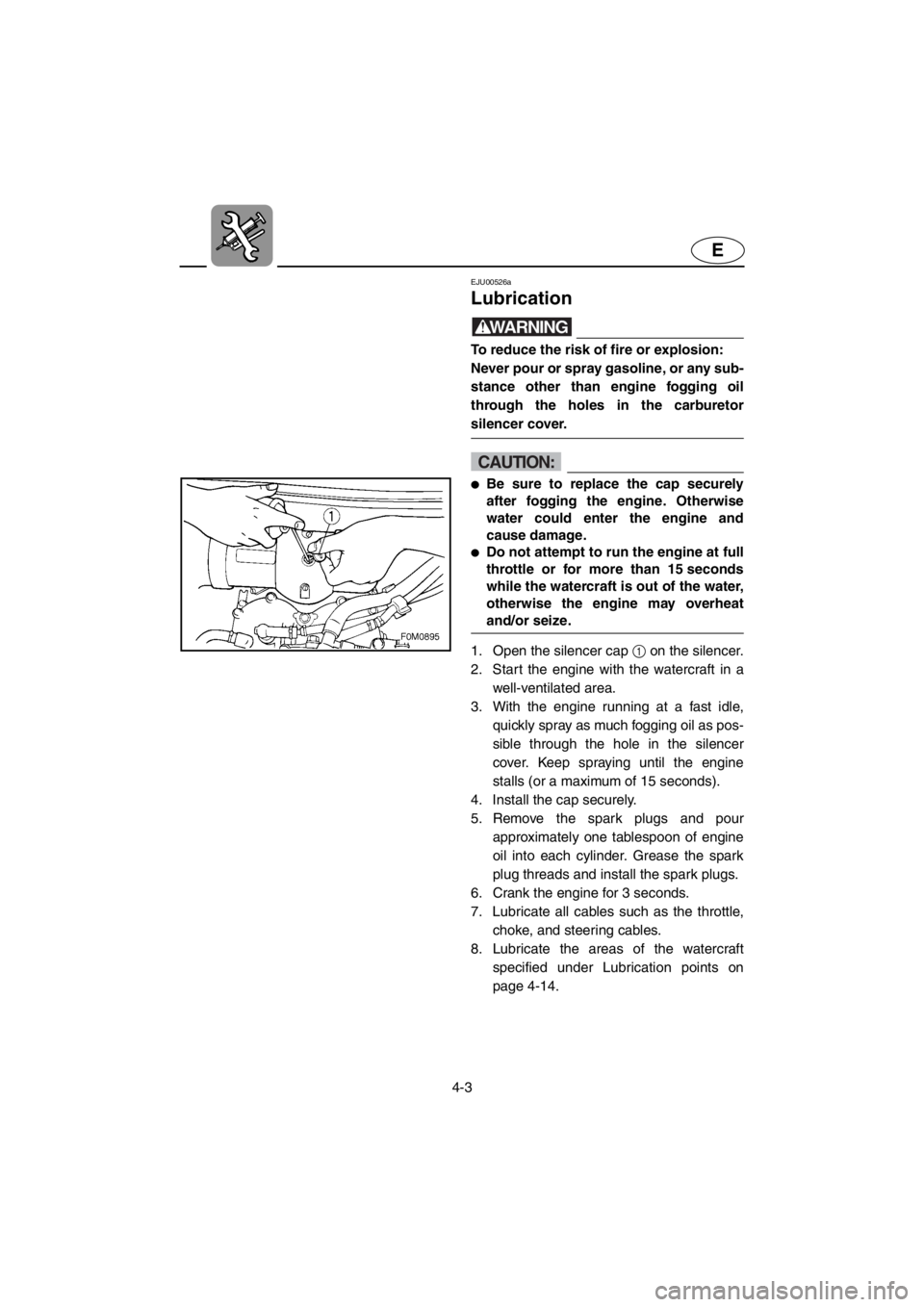
4-3
E
EJU00526a
Lubrication
WARNING
To reduce the risk of fire or explosion:
Never pour or spray gasoline, or any sub-
stance other than engine fogging oil
through the holes in the carburetor
silencer cover.
CAUTION:
●Be sure to replace the cap securely
after fogging the engine. Otherwise
water could enter the engine and
cause damage.
●Do not attempt to run the engine at full
throttle or for more than 15 seconds
while the watercraft is out of the water,
otherwise the engine may overheat
and/or seize.
1. Open the silencer cap 1 on the silencer.
2. Start the engine with the watercraft in a
well-ventilated area.
3. With the engine running at a fast idle,
quickly spray as much fogging oil as pos-
sible through the hole in the silencer
cover. Keep spraying until the engine
stalls (or a maximum of 15 seconds).
4. Install the cap securely.
5. Remove the spark plugs and pour
approximately one tablespoon of engine
oil into each cylinder. Grease the spark
plug threads and install the spark plugs.
6. Crank the engine for 3 seconds.
7. Lubricate all cables such as the throttle,
choke, and steering cables.
8. Lubricate the areas of the watercraft
specified under Lubrication points on
page 4-14.
E_F0M-72-4.fm Page 3 Thursday, July 27, 2000 9:53 AM
Page 96 of 111
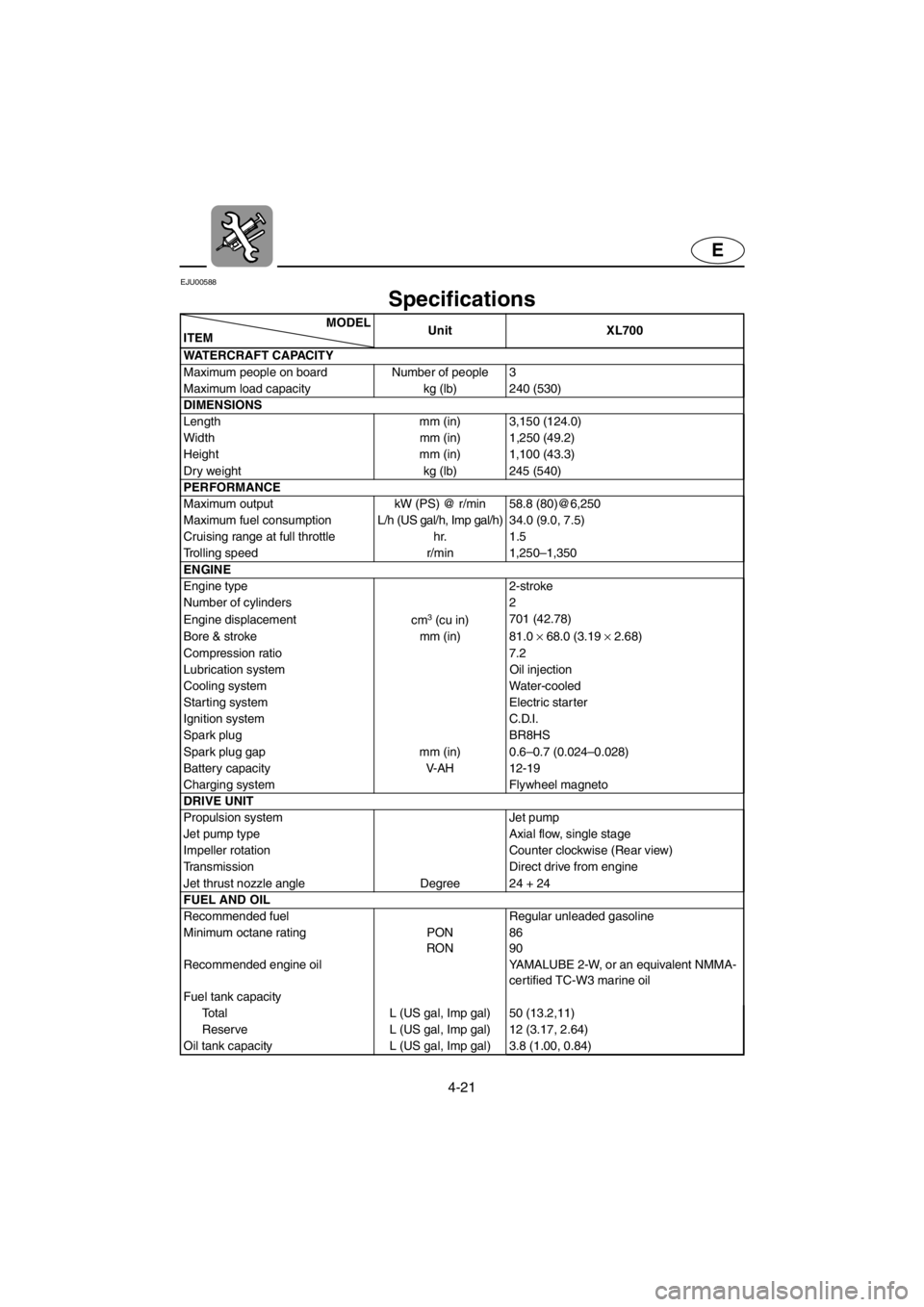
4-21
E
EJU00588
Specifications
MODEL
ITEMUnit XL700
WATERCRAFT CAPACITY
Maximum people on board Number of people 3
Maximum load capacity kg (lb) 240 (530)
DIMENSIONS
Length mm (in) 3,150 (124.0)
Width mm (in) 1,250 (49.2)
Height mm (in) 1,100 (43.3)
Dry weight kg (lb) 245 (540)
PERFORMANCE
Maximum output kW (PS) @ r/min 58.8 (80)@6,250
Maximum fuel consumption L/h (US gal/h, Imp gal/h) 34.0 (9.0, 7.5)
Cruising range at full throttle hr. 1.5
Trolling speed r/min 1,250–1,350
ENGINE
Engine type 2-stroke
Number of cylinders 2
Engine displacement
cm
3 (cu in)701 (42.78)
Bore & stroke mm (in) 81.0 ×
68.0 (3.19 ×
2.68)
Compression ratio 7.2
Lubrication system Oil injection
Cooling system Water-cooled
Starting system Electric starter
Ignition system C.D.I.
Spark plug BR8HS
Spark plug gap mm (in) 0.6–0.7 (0.024–0.028)
Battery capacity V-AH 12-19
Charging system Flywheel magneto
DRIVE UNIT
Propulsion system Jet pump
Jet pump type Axial flow, single stage
Impeller rotation Counter clockwise (Rear view)
Transmission Direct drive from engine
Jet thrust nozzle angle Degree 24 + 24
FUEL AND OIL
Recommended fuel Regular unleaded gasoline
Minimum octane rating PON
RON86
90
Recommended engine oil YAMALUBE 2-W, or an equivalent NMMA-
certified TC-W3 marine oil
Fuel tank capacity
Total L (US gal, Imp gal) 50 (13.2,11)
Reserve L (US gal, Imp gal) 12 (3.17, 2.64)
Oil tank capacity L (US gal, Imp gal) 3.8 (1.00, 0.84)
E_F0M-72-4.fm Page 21 Thursday, July 27, 2000 9:53 AM
Page 99 of 111
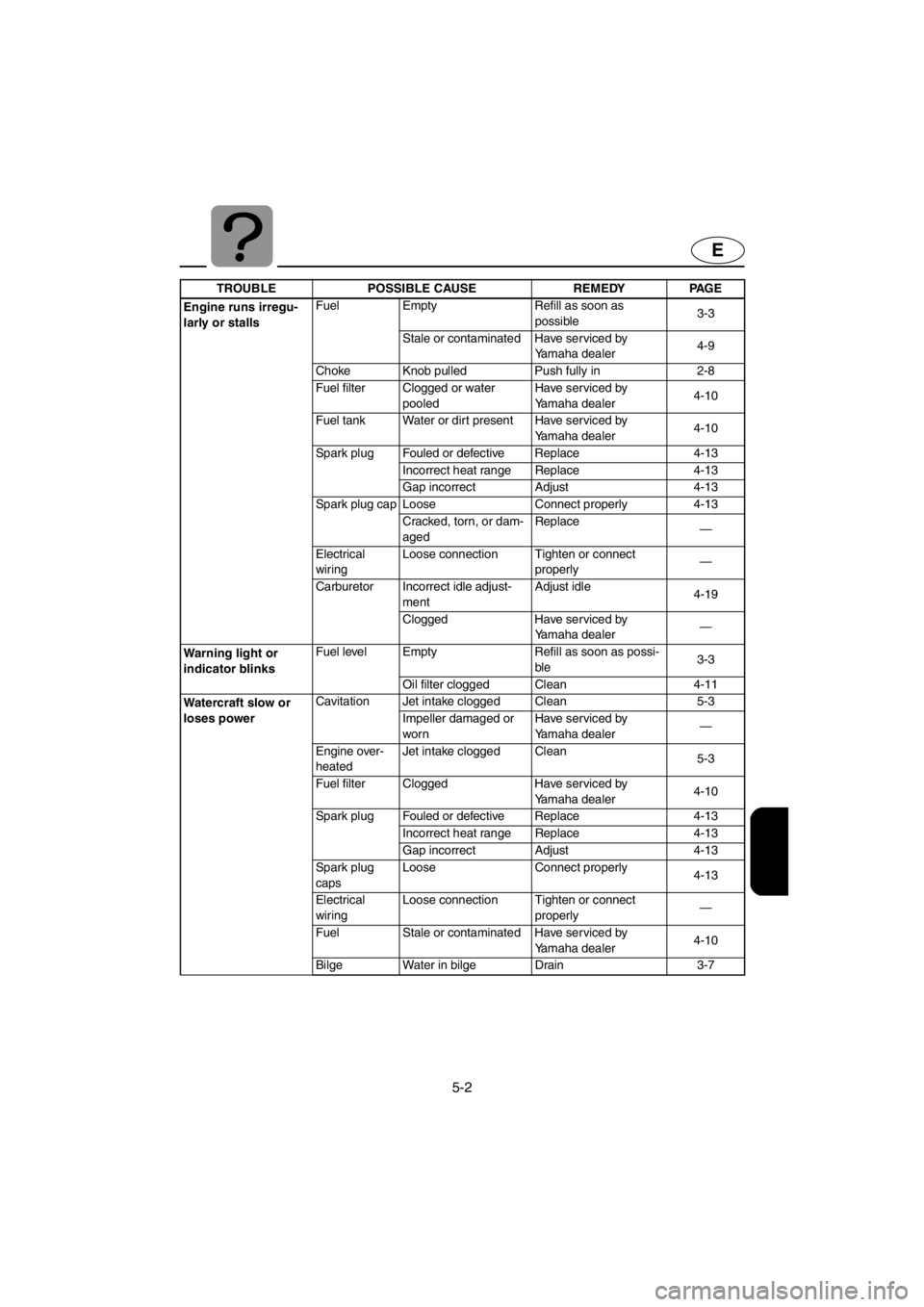
5-2
E
Engine runs irregu-
larly or stallsFuel Empty Refill as soon as
possible3-3
Stale or contaminated Have serviced by
Yamaha dealer4-9
Choke Knob pulled Push fully in 2-8
Fuel filter Clogged or water
pooledHave serviced by
Yamaha dealer4-10
Fuel tank Water or dirt present Have serviced by
Yamaha dealer4-10
Spark plug Fouled or defective Replace 4-13
Incorrect heat range Replace 4-13
Gap incorrect Adjust 4-13
Spark plug cap Loose Connect properly 4-13
Cracked, torn, or dam-
agedReplace
—
Electrical
wiringLoose connection Tighten or connect
properly—
Carburetor Incorrect idle adjust-
mentAdjust idle
4-19
Clogged Have serviced by
Yamaha dealer—
Warning light or
indicator blinksFuel level Empty Refill as soon as possi-
ble3-3
Oil filter clogged Clean 4-11
Wate rcr af t slow or
loses powerCavitation Jet intake clogged Clean 5-3
Impeller damaged or
wornHave serviced by
Yamaha dealer—
Engine over-
heatedJet intake clogged Clean
5-3
Fuel filter Clogged Have serviced by
Yamaha dealer4-10
Spark plug Fouled or defective Replace 4-13
Incorrect heat range Replace 4-13
Gap incorrect Adjust 4-13
Spark plug
capsLoose Connect properly
4-13
Electrical
wiringLoose connection Tighten or connect
properly—
Fuel Stale or contaminated Have serviced by
Yamaha dealer4-10
Bilge Water in bilge Drain 3-7 TROUBLE POSSIBLE CAUSE REMEDY PAGE
E_F0M-72-5.fm Page 2 Thursday, July 27, 2000 9:58 AM
Page 101 of 111
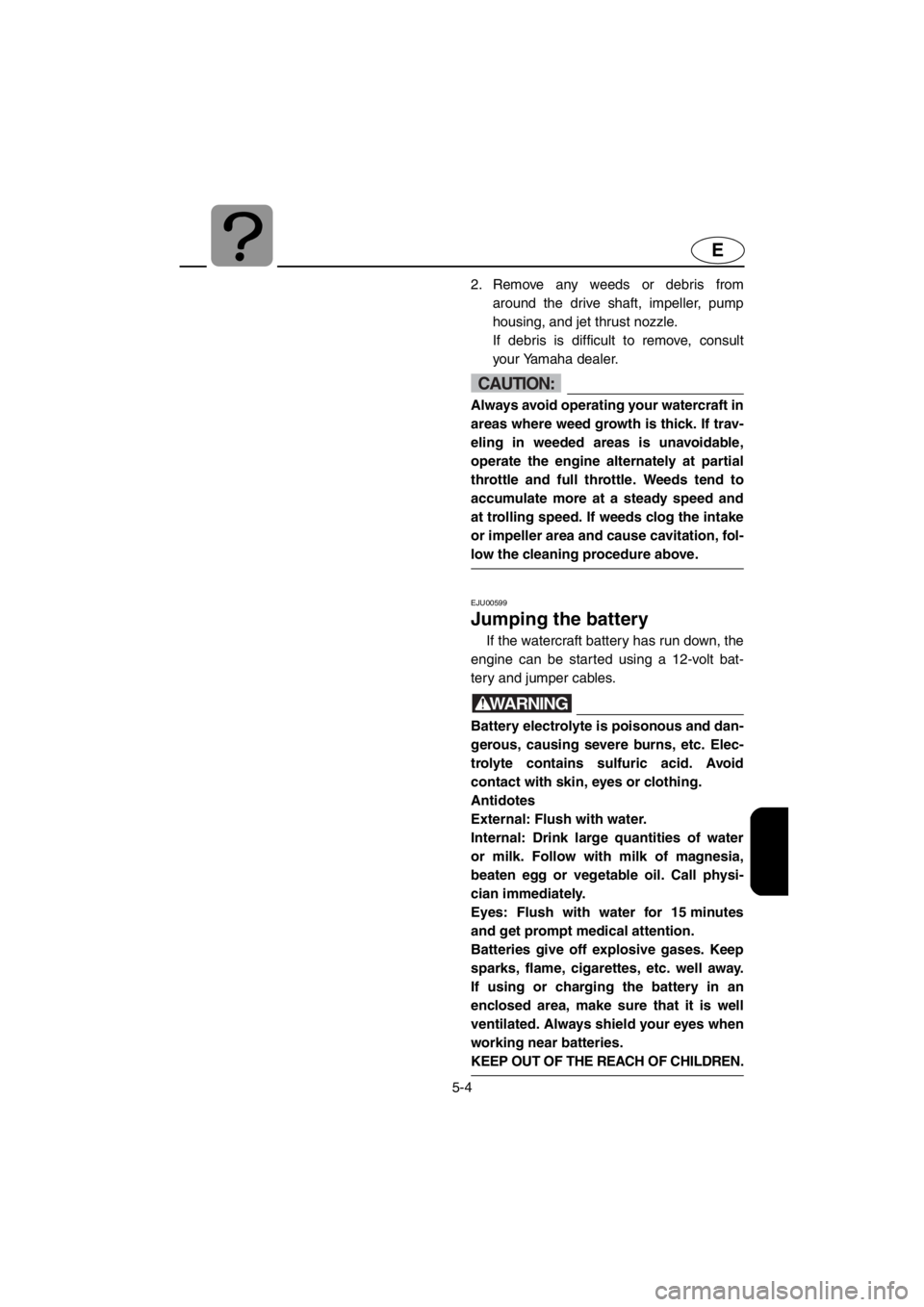
5-4
E
2. Remove any weeds or debris from
around the drive shaft, impeller, pump
housing, and jet thrust nozzle.
If debris is difficult to remove, consult
your Yamaha dealer.
CAUTION:
Always avoid operating your watercraft in
areas where weed growth is thick. If trav-
eling in weeded areas is unavoidable,
operate the engine alternately at partial
throttle and full throttle. Weeds tend to
accumulate more at a steady speed and
at trolling speed. If weeds clog the intake
or impeller area and cause cavitation, fol-
low the cleaning procedure above.
EJU00599
Jumping the battery
If the watercraft battery has run down, the
engine can be started using a 12-volt bat-
tery and jumper cables.
WARNING
Battery electrolyte is poisonous and dan-
gerous, causing severe burns, etc. Elec-
trolyte contains sulfuric acid. Avoid
contact with skin, eyes or clothing.
Antidotes
External: Flush with water.
Internal: Drink large quantities of water
or milk. Follow with milk of magnesia,
beaten egg or vegetable oil. Call physi-
cian immediately.
Eyes: Flush with water for 15 minutes
and get prompt medical attention.
Batteries give off explosive gases. Keep
sparks, flame, cigarettes, etc. well away.
If using or charging the battery in an
enclosed area, make sure that it is well
ventilated. Always shield your eyes when
working near batteries.
KEEP OUT OF THE REACH OF CHILDREN.
E_F0M-72-5.fm Page 4 Thursday, July 27, 2000 9:58 AM
Page 106 of 111

6-1
E
EJU00609
Index
2-stroke engine oil ................................... 3-3
A
Adjusting the carburetor ........................ 4-19
Adjusting the choke cable ..................... 4-16
Adjusting the trolling speed ................... 4-19
Approval label of Emission control
certificate ................................................. 1-2
B
Battery .............................................. 3-8, 4-4
Beaching the watercraft ........................ 3-30
Bilge ........................................................ 3-7
Bleeding the oil injection pump ............. 4-20
Boarding alone ...................................... 3-23
Boarding and starting in deep water ..... 3-23
Boarding with passengers ..................... 3-24
C
Capsized watercraft .............................. 3-25
Caution labels ......................................... 1-7
Choke knob ............................................. 2-8
Cleaning and adjusting the spark
plugs...................................................... 4-13
Cleaning the jet intake and impeller ........ 5-3
Cleaning the watercraft ........................... 4-5
Connecting the jumper cables................. 5-5
Cooling water pilot outlet .............. 2-10, 3-12
Cruising limitations ................................ 1-10
D
Docking the watercraft .......................... 3-30
E
Emergency procedures ........................... 5-3
Emission control information ................... 1-2
Engine break-in ..................................... 3-13
Engine compartment ............................... 3-6
Engine overheat warning system .......... 2-11
Engine serial number .............................. 1-1
Engine shut-off cord (lanyard) ............... 3-11
Engine shut-off switch ............................. 2-8
Engine stop switch .................................. 2-8
Enjoy your watercraft responsibly ......... 1-17F
Filling the fuel tank .................................. 3-3
Filling the oil tank .................................... 3-4
Fire extinguisher ...................................... 3-9
Flushing the cooling system .................... 4-1
Front seat ................................................ 2-5
Front storage compartment ................... 2-13
Fuel and oil.............................................. 3-1
Fuel and oil systems ............................... 3-6
Fuel cock knob ........................................ 2-7
Fuel filter ............................................... 4-10
Fuel system ............................................. 4-4
Fuel tank ............................................... 4-10
Fuel tank filler cap ................................... 2-6
G
Gasohol ................................................... 3-2
Gasoline .................................................. 3-1
Getting to know your watercraft ............ 3-19
Glove compartment ............................... 2-14
H
Handgrip ................................................ 2-12
Hazard information ................................ 1-13
Hood........................................................ 2-6
Hull Identification Number (HIN).............. 1-1
I
Identification numbers ............................. 1-1
Important labels ....................................... 1-3
Inspecting and adjusting the throttle
cable...................................................... 4-12
Inspecting the battery ............................ 4-17
Inspecting the fuel system ....................... 4-9
Inspecting the oil injection system ......... 4-11
Inspecting the steering cable................ 4-12
J
Jet unit................................................... 3-11
Jumping the battery ................................. 5-4
L
Label location .......................................... 1-3
Learning to operate your watercraft ...... 3-19
Leaving the watercraft ........................... 3-18
Limitations on who may operate the
watercraft ................................................ 1-9
Location of main components ................. 2-1
E_F0M-72IX.fm Page 1 Thursday, July 27, 2000 9:58 AM
Page 107 of 111

6-2
E
Lubrication............................................... 4-3
Lubrication points .................................. 4-14
M
Maintenance and adjustments ................ 4-6
O
Oil filter .................................................. 4-11
Oil level warning lamp ........................... 2-12
Oil tank .................................................. 4-11
Oil tank filler cap...................................... 2-6
Operating your watercraft...................... 3-19
Operation .............................................. 3-13
Operation of controls and other
functions .................................................. 2-4
Operation requirements ........................ 1-11
Other labels ............................................. 1-8
Owner’s/Operator’s Manual and tool
kit............................................................. 4-7
P
Periodic maintenance chart..................... 4-8
Post-operation checks........................... 3-31
Pre-operation check list........................... 3-5
Pre-operation check points ..................... 3-6
Pre-operation checks .............................. 3-5
Primary Identification (PRI-ID) number ... 1-1
R
Rear seat................................................. 2-4
Replacing the fuse ................................ 4-20
Riding watercraft with passengers ........ 3-20
Rough water operation .......................... 3-30
S
Safe boating rules ................................. 1-16
Safety information ................................... 1-9
Seat storage compartment .................... 2-14
Specifications ........................................ 4-21
Starting and boarding in shallow
water ..................................................... 3-22
Starting from a dock .............................. 3-22
Starting the engine ................................ 3-15
Starting the watercraft ........................... 3-21
Start switch.............................................. 2-9
Steering system ........................... 2-10, 3-10
Stopping the engine .............................. 3-18
Stopping the watercraft ......................... 3-29Storage.................................................... 4-1
Storage compartments .......................... 2-13
Submerged watercraft ............................. 5-7
Switches ................................................ 3-12
T
Throttle .................................................. 3-10
Throttle lever ........................................... 2-9
Towing the watercraft .............................. 5-6
Transporting .......................................... 3-33
Troubleshooting ...................................... 5-1
Troubleshooting chart ............................. 5-1
Turning the watercraft ........................... 3-27
W
Warning labels ........................................ 1-4
Watercraft characteristics ...................... 1-14
Water separator ...................................... 3-7
Water-skiing .......................................... 1-15
E_F0M-72IX.fm Page 2 Thursday, July 27, 2000 9:58 AM